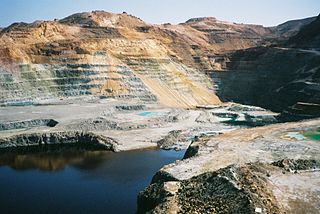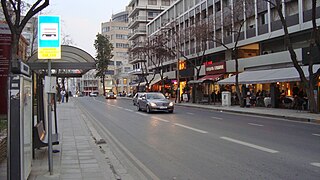 W
WThe economy of Cyprus is a high-income economy as classified by the World Bank, and was included by the International Monetary Fund in its list of advanced economies in 2001. Cyprus adopted the euro as its official currency on 1 January 2008, replacing the Cypriot pound at an irrevocable fixed exchange rate of CYP 0.585274 per €1.
 W
WAgriculture in Cyprus constituted the backbone of its economy when it achieved its independence in 1960. It mostly consisted of small farms, and sometimes even subsistence farms. During the 1960s, irrigation projects made possible vegetable and fruit exports; increasingly commercialized farming was able to meet the demands for meat, dairy products, and wine from the British and United Nations troops stationed on the island and from the growing number of tourists.
 W
WThe mining industry of Cyprus is synonymous with copper extraction which began around 4,000 BC. Copper dominates the mining sector along with mining of iron pyrite, gold, chromites and asbestos fibers, bentonite, cement, and also petroleum. Though at one time, copper was a mainstay of the economy, as of 2012, the mining sector does not contribute in a significant way to the GNP.
 W
WThe Cyprus Securities and Exchange Commission, better known as CySEC, is the financial regulatory agency of Cyprus. As an EU member state, CySEC's financial regulations and operations comply with the European MiFID financial harmonization law.
 W
WLedra Street is a major shopping thoroughfare in central Nicosia, Cyprus, which links North Nicosia, the part of the city under the control of the de facto Northern Cyprus, and south Nicosia.
 W
WMakarios Avenue is an avenue in the centre of Nicosia, Cyprus which covers a distance of 2 kilometres (1.2 mi). The Street starts from the Junction of Evagoras Avenue until Aglandjia Avenue and is named after the first President of Cyprus Archbishop Makarios III. In Colonial times Makarios Avenue was named Pluto Street. and was the main route to Limassol, it was lined with residential buildings such as the Lyssiotis Mansion built in 1928 and is now the Head Office of the National Bank of Greece in Cyprus. The area has been transformed into a commercial district with many of the original buildings demolished to make way for shops and office blocks. Makariou Avenue is parallel to Stasikratous Street and Themistokli Dervi Avenue.
 W
WThe island of Cyprus first issued revenue stamps in 1878 and continues to do so to this day. The Turkish Republic of Northern Cyprus also issues its own revenue stamps.
 W
WTourism in Cyprus occupies a dominant position in the country's economy, and has significantly impacted its culture and multicultural development throughout the years. In 2006, the tourism industry made up 10.7% of the country's GDP and the total employment in the tourism industry was estimated at 113,000 jobs. With a usual minimum of around 4 million tourist arrivals per year, it is the 40th most popular destination in the world and the 6th most popular per capita of local population. Cyprus has been a full member of the World Tourism Organization since 1975.